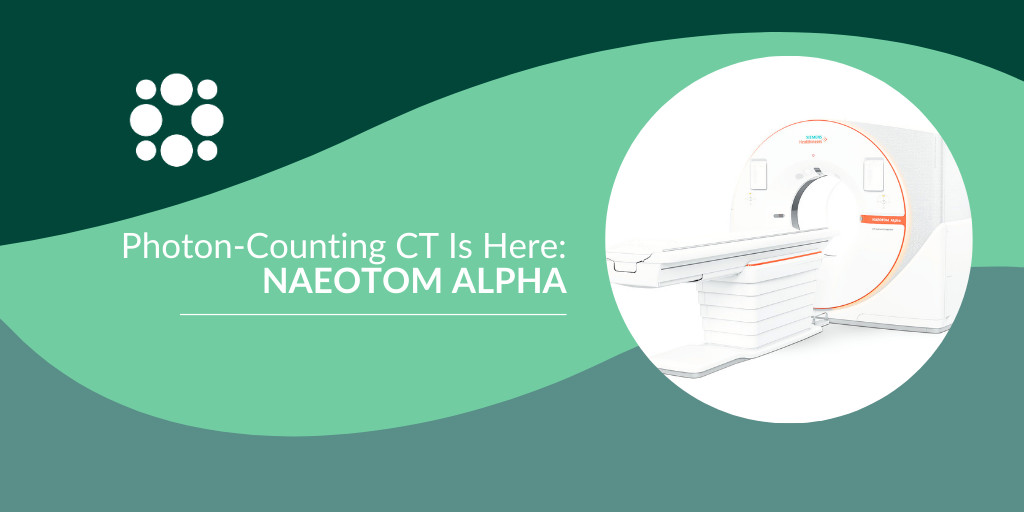In an industry where powerful technology can make a considerable difference in scan quality, speed, and overall patient results, innovation is everything.
This is especially true for Computed Tomography, or CT, one of the more frequently used forms of medical imaging. Thanks to the incredible scientists working to push the technology forward each day, a promising advancement is on the rise: Photon Counting. This innovative technology aims to produce higher image quality, reduce radiation exposure, and heighten diagnostic accuracy. By prioritizing factors like these, there is clear potential to revolutionize patient care.
In this post we want to look at not only the science behind what makes Photon-counting CT possible, but also how our advanced partner, Siemens Healthineers, is implementing this technology with its NAEOTOM Alpha CT – and most importantly, what it means for patients.
What is Photon-counting?
To accurately detail the significance of Photon-counting, we must first explain how traditional CT machines operate.
In 1975 Siemens1 introduced the SIRETOM, the first scanner from a medical manufacturer using Computed Tomography. CT is an imaging procedure in which a narrow beam of X-rays is aimed at a patient, and the machine then quickly rotates around the body; as the X-rays leave the patient, they are picked up by special digital X-ray detectors located directly opposite to the x-ray source and transmitted to a computer to be processed by applying sophisticated mathematical techniques to create cross-sectional images of the body.
The technology has had its share of innovations over the years, with Dual Source CT introduced in 2005, increasing scanning speed and enabling non-beta blocker cardiac imaging; Wide Detector CT introduced in 2007, enabling dynamic scanning of the heart; and Dual Layer CT detectors introduced in 2013, which separated x-ray photons in low and high energy levels, allowing image scans with more parameters for each individual scan. Each evolution brought technological growth for the modality, but the way the core system operates has remained generally the same over the years.
The science behind a CT involves photons being sent from an X-ray source through the patient and recorded by a detector that contains multiple elements. Normally with CT, these thousands of photons are counted in volumes by the detector elements. However, thanks to the introduction of the photon-counting scanner, all these photons that produce the images can be counted individually due to the innovative detector technology, allowing better image resolution and dose reduction to the patient.
So, we have reached the latest step in the evolution of CT–photon counting.
Why is it important?
Beyond allowing for enhanced clarity and detail in the patient scans, this improved technology may also lead to time savings—time saved for patients, time saved for doctors, and time saved for the technicians who are performing the scans.
Greater visual clarity means clearer indication of what is happening to a patient’s body and what might be causing the issue. This means quicker decision making is made possible and more lives have the potential to be improved as a direct result.
Our advanced partners at Siemens Healthineers have not only managed to harness this technology for innovation moving forward but have also already introduced and brought to market the world’s first commercially available Photon-counting CT device, the NAEOTOM Alpha.
Introduced to the world in 2021, the NAEOTOM Alpha Photon-counting CT has brought a new wave of optimism for the future of the technology. For example, look at direct quotes from CT Technologist Nichole Pool, R.T. (R)(CT) featured in a Siemens Healthineers video filmed at the Medical University of South Carolina (MUSC) to promote their partnership on the NAEOTOM Alpha, detailing the impact that the device can have on patients:
“We’re able to perform more coronary CTA exams on patients that may have had more of a calcium burden, or patients that were unable to hold still or hold their breath for a full exam, and now we’re able to do these scans for these patients to really help them out and get them the help that they need.” 2
Pool continued, explaining the positive impact of the increased visual quality, as well:
“Seeing the images for the first time was really amazing; we’re just getting better-detailed images with less dose to a patient, so we’re actually able to see smaller, more important details as in coronaries or even smaller details of lungs.” 2
The impacts of the NAEOTOM Alpha have the potential to exceed the technical benefits as well, as Pool noted how she and fellow technologists can connect with their patients:
“We’re actually able to stay in the room with them a little bit more because we have a tablet that is a part of the machine, so we can bring the patients’ exam up in the room, we can talk with the patient…That means a lot, especially for patients that may be a little nervous… and kinda make them feel a little more at ease.” 2
In an environment that has a high potential to feel cold, isolating, and scary for many patients, an increase in our ability to connect with people goes a long way.
When is it available?
As of 2023, the NAEOTOM Alpha CT is available at a growing number of locations throughout the US, and we are excited to have the device in our South Florida territory at one of our customer locations, as well. As the technology continues to be made available, more patients will be able to receive increased precision with their scans and benefit from all the positives that the NAEOTOM Alpha and Photon-counting CT technology provides.
References/Read more:
1https://www.siemens-healthineers.com/computed-tomography/news/mso-the-history-of-ct-1.html
The statements by Siemens Healthineers’ customers described herein are based on results that were achieved in the customer’s unique setting. Since there is no “typical” hospital and many variables exist (e.g., hospital size, case mix, level of IT adoption) there can be no guarantee that other customers will achieve the same results.
